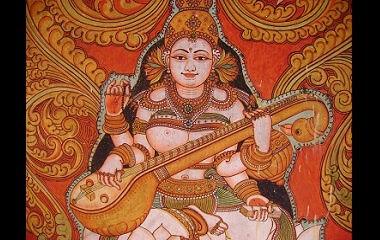- Pronunciation: suh-ruhs-wuh-tee
- Origin: Hindu
- Role: Goddess of wisdom, learning, aesthetics and music
- Father: Brahma
- Husband: Brahma
- Symbols: White lotus flower, swan, veena (string instrument)
Who is Saraswati?
Saraswati is a Hindu goddess. Her name means watery, flowing, or elegant. Originally her name was ascribed to the Saraswati River, but later the sacred river was personified and took the form of the deity. The Saraswati River, today called the Sarsuti River, is known to provide good fortune to those who bathe in it, as well as fertility and purification.
The goddess is believed to be the creator of Sanskrit (meaning perfectly done), the ancient language of Hinduism. She is often the muse of Hindu artists and is worshiped in India and Nepal. Saraswati forms part of a trinity of goddesses called the Trivedi, along with Lakshmi and Parvati. She is also known as Bharti, meaning eloquence or Vedamata, mother of the Vedas, and Shatarupa, meaning existence.
Origin
Saraswati is noted first in the Rigveda, ancient Sanskrit hymns dating back to approximately 1500 – 1200 BC. The goddess has been worshiped since the Vedic period and is still worshiped today.
Legends and Stories
She is represented differently in the legends of various regions. Many temples are dedicated to her, including the Gnana Saraswati Temple in India, which is visited by pilgrims each year.
The Curse of Saraswati
In the curse of Saraswati, the goddess curses her husband when she sees him participating in a religious ceremony with another woman, instead of her. Brahma had been waiting for his wife to join him, but she was late and delaying the important ceremony. Brahma prayed to the gods for advice and they answered by creating a new wife for him. When Saraswati came upon the new woman, who had seemingly replaced her, she cursed her husband. He was never to be worshiped again.
Saraswati and the Song of the Gandharva
One day, demigods, called Gandharvas emerged from the scent of flowers. The Gandharvas stole a plant which was cherished by the deities, the Soma plant. The plant held sap which was intoxicating and invigorating. Saraswati went to the demigod’s dwelling place to reclaim the special plant and enchanted the thieves with her veena, a classical stringed musical instrument. The Gandharvas were entranced and begged her for her mystical music. The goddess agreed to teach them, but in exchange, she wanted the Soma plant. The terms were agreed upon and she taught them to play music as she did. The demigods later excelled at the music, to such a degree, that their melodies had more power than the intoxicating plant.
Saraswati and Shiva’s Third Eye
Shiva, the destroyer of the universe, one day looked down at the world and saw how evil and corrupt it had become. He decided the only solution was to wipe out everything with his destructive third eye and opened it. A vicious fire emanated from his third eye, to destroy the three worlds; the physical world, the ancestor’s world and the home of the gods. Saraswati did not agree with him. She placated the people, saying those who were pure would not be destroyed. In order to save them, she transformed herself into a river and her pure waters absorbed the deadly fire.
Festivals
The festival, Saraswati Puja, is held on the first day of spring. She is worshiped with offerings of yellow and white flowers, books, inkpots, and instruments to invoke her blessing in music and writing. Followers wear yellow, which is associated with wisdom, and also adorn statues of Saraswati in yellow silk. Nobody reads or writes a book on the day, with the exception of young children. It is the ideal day for them to learn to write and they do so in a ceremony called Hatey-Khori. The ceremony is believed to set one up to be a learned person. Students frequently pray to the goddess before exams, as the goddess of wisdom and musicians before a show, as the goddess of music, or simply before a lesson of any kind.
Family
The goddess’ husband is Brahma and her son, the sage, Sarasvata. In certain Hindu beliefs, the first man, Manu, was also born from the union of the goddess and Brahma. Manu wrote the Manu-smriti or Laws of Manu, in approximately 100 AD, prescribing the dharma to Hindus.
Appearance
The goddess is depicted as a young woman with white skin, often wearing a white sari. Her disinterest in material possessions is shown by her not wearing any jewelry or bright colors. She is often depicted as seated on a lotus flower or riding a goose or swan. Saraswati is usually shown clutching symbolic objects in her four arms. The objects on the left are a water vessel, signifying purification, and a palm-leaf manuscript. On the right, one hand performs the varada mudra, the ceremony for giving gifts, while the other holds a white lotus flower. Alternatively, she is also frequently seen holding, a classical Hindu musical instrument called a veena, representing the creativity of the arts and the emotions conveyed by music.











Great God